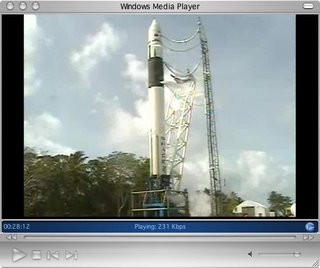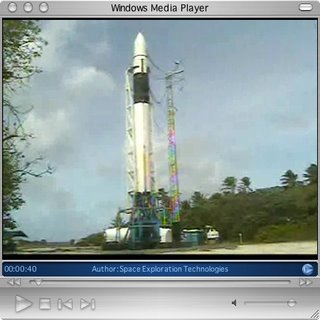The team is on Omelek collecting debris.
The rocket impacted on a dead reef about 250 ft away from the launch pad, so most of it is recoverable for analysis.
Amazingly, the satellite was thrown high into the air when the rocket impacted and came crashing down through the roof of our machine shop, landing mostly intact on the floor! One helluva' return trip.
The hole in the machine shop roof is the only significant damage to the island.
Saturday, March 25, 2006
Someone's looking out for that satellite...
Hi-Res photos of launch
SpaceX has just released photos of the launch showing the fire in the engine.
 Falcon on it's way - guidance showed it on track and headed for a successful trip. Looking closely, a likely fuel leak has resulted in a fire in the engine.
Falcon on it's way - guidance showed it on track and headed for a successful trip. Looking closely, a likely fuel leak has resulted in a fire in the engine.K Digg It!
Post-Launch Analysis
As most of you know by now, the rocket was lost.
From Elon this morning:
"Preliminary Fault Analysis
The good news is that all vehicle systems, including the main engine, thrust vector control, structures, avionics, software, guidance algorithm, etc. were picture perfect. Falcon's trajectory was within 0.2 degrees of nominal during powered flight.
However, at T+25s, a fuel leak of currently unknown origin caused a fire around the top of the main engine that cut into the first stage helium pneumatic system. On high resolution imagery, the fire is clearly visible within seconds after liftoff. Once the pneumatic pressure decayed below a critical value, the spring return safety function of the pre-valves forced them closed, shutting down the main engine at T+29s.
It does not appear as though the first stage insulation played a negative role, nor are any other vehicle anomalies apparent from either the telemetry or imaging. Falcon was executing perfectly on all fronts until fire impaired the first stage pneumatic system.
Our plan at this point is to analyze data and debris to be certain that the above preliminary analysis is correct and then isolate and address all possible causes for the fuel leak. In addition, we will do another ground up systems review of the entire vehicle to flush out any other potential issues.
I cannot predict exactly when the next flight will take place, as that depends on the findings of this investigation and ensuring that our next customer is comfortable that all reasonable steps have been taken to ensure reliability. However, I would hope that the next launch occurs in less than six months.
It is perhaps worth noting that those launch companies that succeeded also took their lumps along the way. A friend of mine wrote to remind me that only 5 of the first 9 Pegasus launches succeeded; 3 of 5 for Ariane; 9 of 20 for Atlas; 9 of 21 for Soyuz; and 9 of 18 for Proton. Having experienced firsthand how hard it is to reach orbit, I have a lot of respect for those that persevered to produce the vehicles that are mainstays of space launch today.
I am very encouraged and grateful that our launch customers took the time to call and express their support of SpaceX when their reaction could easily have been the opposite. We will stand by them as they have stood by us. SpaceX is in this for the long haul and, come hell or high water, we are going to make this work.
As SpaceX is a company that believes in maximum disclosure (within the boundaries of proprietary data and ITAR restrictions), I will try to post as much as possible about this launch attempt over the coming weeks.
--- Elon"
Some photos from the webcam:
Friday, March 24, 2006
T-Minus 3 minutes
You know that Video Camera I've mentioned the past few days? The one that caused the static fire to abort earlier in the week?
Well, it's actually pretty cool. We have it there so that we can all see what the rocket sees through the webcam.
Did I mention there was a webcam?
http://www.spacex.com/?content=webcast
T-minus 3 minutes
T-Minus 10 minutes
The strongback has been lowered and Auto-Sequence has begun.
The previous times that auto-sequence has occurred, the computer has aborted for a variety of reasons:
1. Glitch in the Video Camera
2. Power Surge/drop on the launch pad
3. Ground helium supply disconnected itself prematurely
All of those were enough to abort the launch. Wednesday's static fire had zero issues and no aborts.
There is every reason to expect that we will go all the way to launch.
Very exciting.
Of course, once the rocket takes off, then we see a whole bunch of things that we cannot test.
We want the stages to disconnect; we want the stage 2 engine to fire up correctly; we want the ferring to separate nicely; and we want the satellite to deploy perfectly.
Don't go away when the launch happens. It ain't over until the satellite is up and on.
K Digg It!
T-minus 30 Minutes!
After a small delay, the team is off the island, and we are now outside the window where we would hit the Internation Space Station with the rocket.
Probably worth waiting a little bit as I don't think NASA has much of a sense of humor. It would be funny though, just not funny to them.
Cryogenic chilldown and liquid oxygen load has begun and all systems are green.
Winds and weather looks good. RP1 loading.
K Digg It!
T-minus 2 Hours!
The launch is 2 hours away.
Analysis of the static fire was good.
You'll all be happy to know that in addition to honing our rocket launching skills, we have been honing our webcasting prowess.
Video kills the blogging star:
http://www.spacex.com/?content=webcast
enjoy.
K
Tuesday, March 21, 2006
Static Fire Analysis
From all preliminary accounts, the static fire went off without a hitch.
Falcon was held down for almost three seconds of thrust (T+0.5s), part of which the rocket was under its own guidance and control. i.e. it was on it's way before we shut down the engines.
All systems were green and no aborts were triggered.
In past static fires, the computer has alerted us to every tiny thing that goes wrong. In the case of the static fire over the week-end, a glitch in the video camera caused the whole launch to abort. That may not sound like a serious issue, but every piece of the rocket needs to work perfectly before we can assure a smooth launch.
Today and tomorrow will be a time to analyse all the data around the static fire. If nothing negative comes up, the launch will happen on Thursday at 1pm California time.
I'd rather be in Kwaj :( Digg It!
Static Fire!!
You know all those times I told you I was broadcasting from Boulder, CO?
Well, I wasn't really. I was somewhere else. I can't say where, or they would have to kill me, and then someone would have to kill you; but I wasn't in Boulder.
This time, sadly, I am in Boulder.
I know you don't believe me, so I did what any other person would do when they need to verify location and date.
Of course, for whatever reason the MacBook Pro camera shoots in mirror-image. But if you stare at it for a few minutes, it changes back. Try it. You'll see.
The static fire just went off. It looked successful from the secret webcam, and I'll get an update from control room in a minute.
In the meantime, here's Elon's comments on why the Static Fire was pushed back a few days:
"The countdown and static fire this weekend went smoothly, except that we had a ground helium supply quick disconnect check itself prematurely during engine startup, preventing the engine from reaching full thrust. The next day, we had a glitch with one of our vehicle video cameras. Neither are difficult to fix, but they pushed back our timeline by a few days.
We are planning on another static fire today at about 4pm (CA time), followed by a 1pm launch on March 23 or March 24, provided no issues are detected following analysis of the static fire data.
Another lesson learned for Falcon 9 development: we will test the first flight unit with its actual flight launch mount on our big test stand in Texas (http://www.spacex.com/bfts.jpg). When development is done, the launch mount and the vehicle will be shipped together to the launch site. For Falcon 1, the test stand was quite different from the launch stand, because its primary purpose was engine development of Merlin (http://www.spacex.com/nl/vertical.gif). That forced us to do a lot of launch mount debugging, such as the helium QD problem, in Kwajalein."
Now if I was in Kwaj, I would have been able to say that first hand. And I would be able to tell you right now what is going on in the Control Room.
Sadly, I can't.
But I'll tell you as I get updates.
K Digg It!









